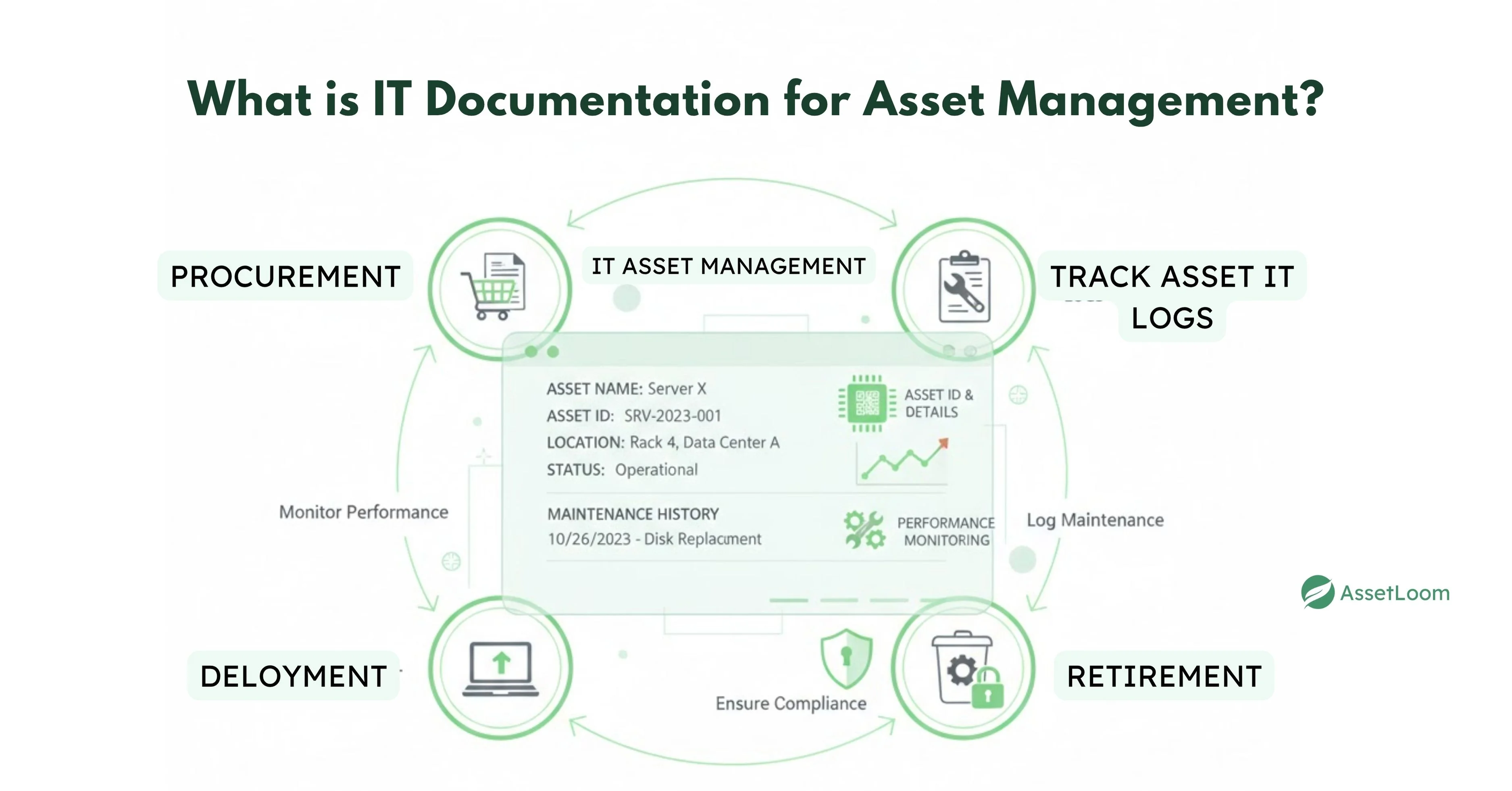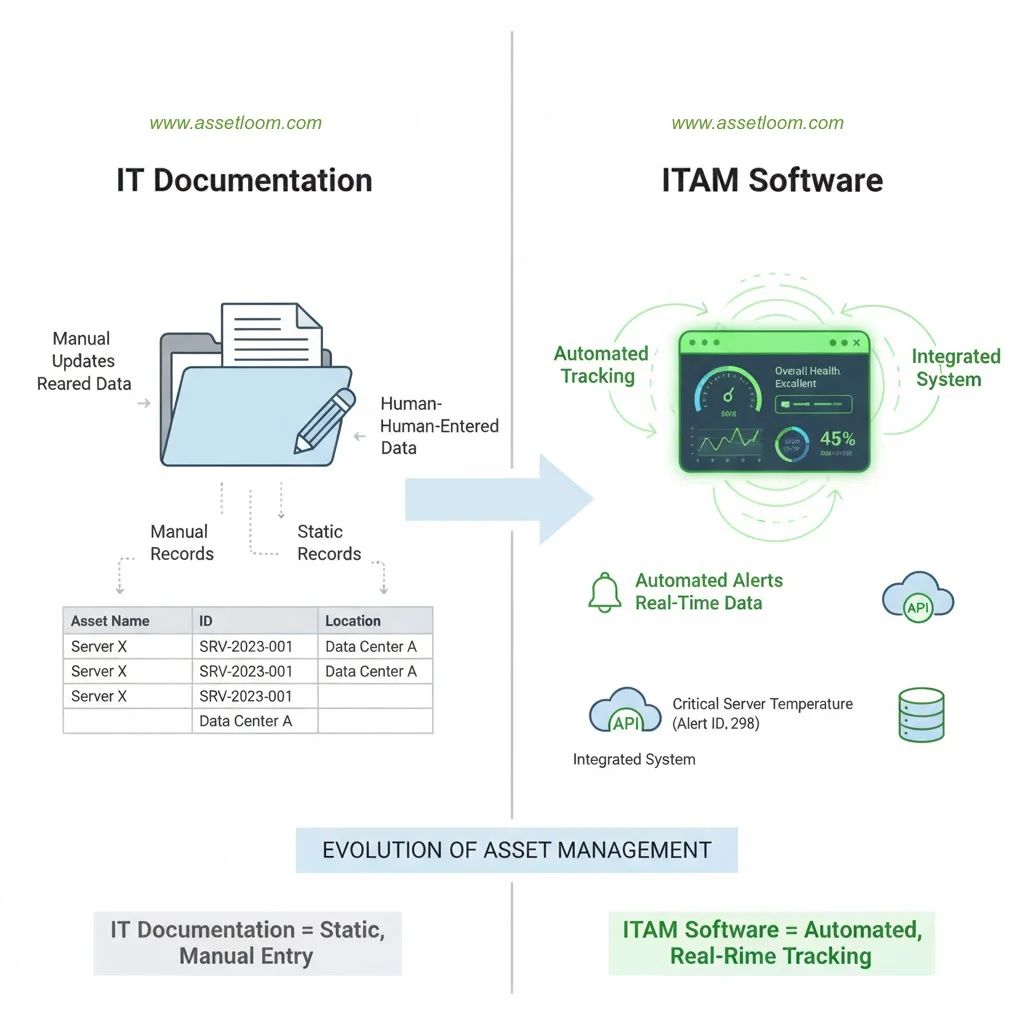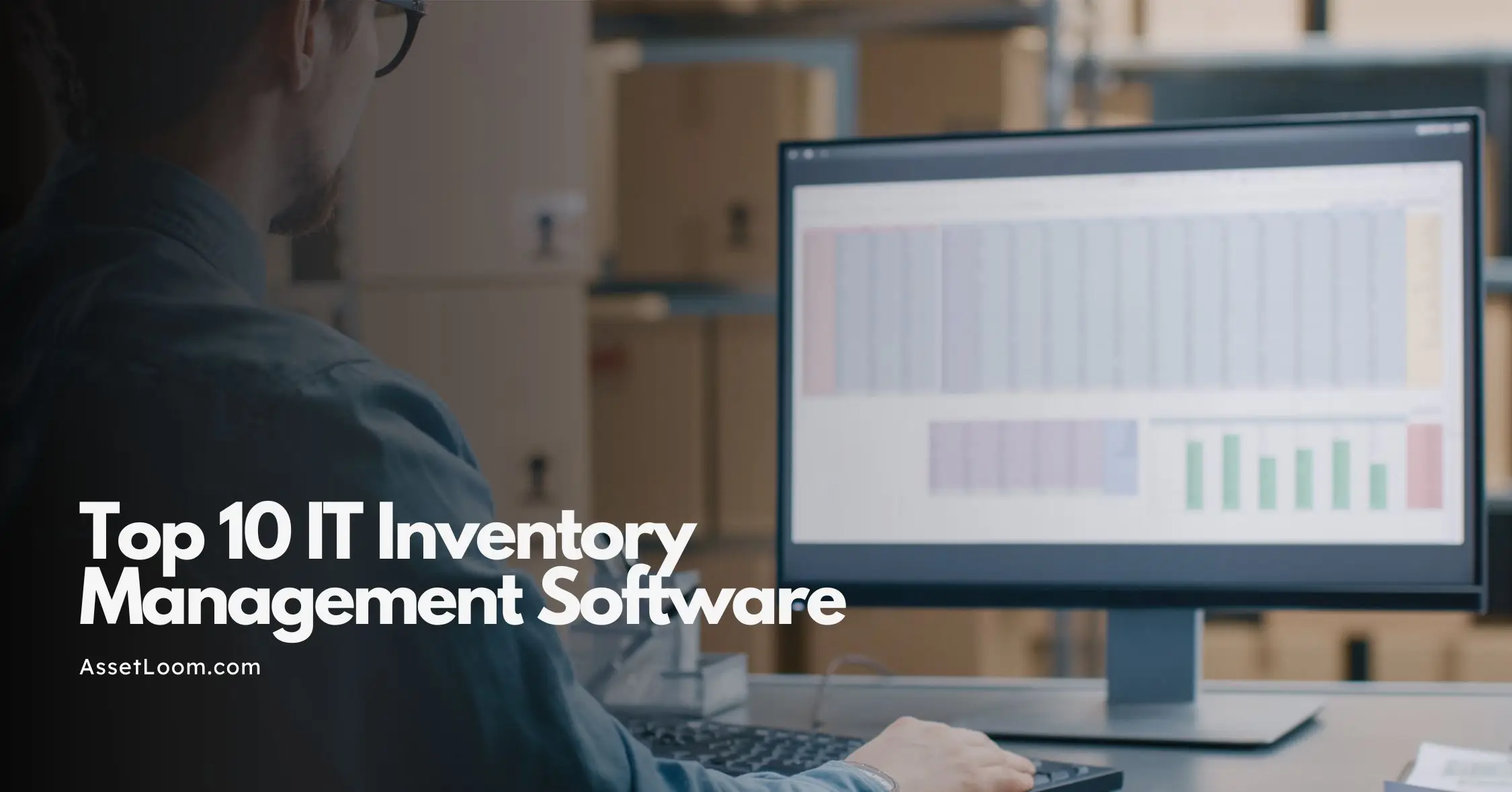How to Use IT Documentation to Track Asset Health in Real-Time
Learn how to leverage IT documentation to track your assets' health in real-time, improving efficiency and preventing costly downtime with proactive monitoring.
Missing devices, outdated hardware, and unplanned downtime can easily throw off a business’s workflow, leading to frustration and unnecessary costs. If your company is still using spreadsheets or disorganized records to keep track of assets, it might be time to rethink the way things are done.
Accurate and up-to-date IT documentation is key to avoiding these problems. It's not just about keeping track of what you have; it's about making sure your assets are working at their best. When you have detailed records of each asset, along with its health status and maintenance history, you can stay ahead of potential issues. Instead of scrambling to fix problems after they occur, you’ll be able to spot early signs of wear and address them before they become costly or disruptive.
What is IT Documentation for Asset Management?
IT documentation for asset management is a detailed record that tracks all aspects of an organization’s IT assets, including hardware, software, and associated information. It covers the entire asset lifecycle from procurement and deployment to maintenance and eventual retirement, ensuring assets are efficiently tracked, properly maintained, and compliant with both internal policies and external licensing agreements.

Key aspects of IT documentation for asset management include:
- Asset Lifecycle Management: This outlines the procedures for each stage of an asset’s life, such as planning, procurement, deployment, maintenance, and retirement. It ensures that every asset is managed and optimized at each stage of its existence.
- Detailed Asset Information: It includes comprehensive data about each asset, such as the asset’s name, owner, location, user, and current status. For software, it may include license details and compliance information, while for hardware, details like manufacturer, model, and serial number are tracked.
- Operational and Technical Data: IT documentation also stores essential operational data, such as user manuals, technical specifications, maintenance records, and service contracts. This ensures that every asset is properly supported and maintained throughout its life.
- Configuration Management Database (CMDB): For more complex IT environments, documentation is often stored in a CMDB. This helps track the relationships between different IT assets, their interdependencies, and how they interact with other systems within the organization.
- Compliance and Security: IT documentation provides an auditable history of each asset, which is crucial for ensuring compliance with regulatory standards, security protocols, and licensing agreements. This documentation can also be used during audits to verify the integrity and legal status of assets.
- Strategic Alignment: By offering a clear, organized picture of the IT landscape, IT documentation helps align asset management with broader business objectives. It aids in improving operational efficiency and supports data-driven decision-making.
By maintaining detailed IT documentation, businesses can ensure their assets are well-managed, secure, and fully optimized, which not only improves daily operations but also reduces long-term costs and compliance risks.
Why Real-Time Asset Health Tracking is Essential
Tracking the health of your assets in real time is crucial for smooth operations. When you can monitor your assets constantly, you catch small issues before they become big problems. This helps prevent downtime, saving both time and money.
By keeping an eye on asset performance, you can make sure they’re being used effectively, preventing waste or overuse. Real-time tracking also allows you to make better decisions about when to repair or replace assets based on up-to-date information.
It also helps with staying compliant with industry regulations, ensuring your assets are properly maintained and meet necessary standards. And by addressing issues early, you can extend the life of your assets, getting more value from them over time.
Real-time health tracking is about being proactive. It lets you stay ahead of potential problems, keep your systems running smoothly, and make smarter decisions for your business.
Key IT Documentation Features for Tracking Asset Health
To effectively track asset health, certain features in your IT documentation are essential. These include:
![]()
Detailed Asset Information
This includes basic details like asset names, locations, owners, and statuses. For hardware, tracking specifications like manufacturer, model, and serial number is key. For software, it’s important to document license details and compliance status.
Maintenance and Service Logs
Keeping a record of all repairs, updates, and issues helps maintain a clear history of each asset. These logs are invaluable for predicting future problems and ensuring proactive maintenance.
Performance Monitoring
Real-time performance data such as CPU usage, memory, and temperature allows you to detect issues before they disrupt operations. Automated alerts can be set up to notify teams when an asset’s health falls below a certain threshold.
Asset Lifecycle Data
Tracking an asset’s journey from procurement to retirement ensures timely maintenance and replacement. Knowing when assets were purchased, serviced, or are due for upgrades helps in managing the overall lifecycle efficiently.
These features work together to give you a clear picture of your assets’ health, enabling you to respond to issues quickly and make informed decisions about repairs, replacements, and upgrades.
IT Documentation vs ITAM software
When it comes to managing IT assets, both IT documentation and IT asset management (ITAM) software play important roles, but they serve different purposes. Understanding the difference between the two can help you make better decisions about how to manage and track your IT assets.

IT Documentation
IT documentation is the process of manually recording and organizing information about assets, including their specifications, usage history, maintenance, and compliance details. It can be done in various formats such as spreadsheets, manuals, or even physical files. The key advantage of IT documentation is that it provides a centralized source of truth for asset-related information. However, it often requires manual updates and can be prone to human error, making it harder to track assets in real time.
ITAM Software
IT asset management software, on the other hand, is a more automated and sophisticated tool designed specifically to manage IT assets throughout their lifecycle. ITAM software can track asset performance, monitor health, handle maintenance schedules, manage software licenses, and ensure compliance—all in real time. Unlike IT documentation, ITAM software often integrates with other systems, providing automatic updates and real-time data about asset conditions. It is much more efficient for tracking large volumes of assets, reducing human error, and improving overall asset management.
Key Differences:
- Manual vs. Automated: IT documentation often requires manual input and updates, while ITAM software automates most of the tracking, monitoring, and reporting processes.
- Real-Time Tracking: ITAM software enables real-time tracking of asset health and performance, whereas IT documentation usually provides static data that requires manual updates.
- Data Integration: ITAM software integrates with other business systems (like inventory or finance), offering a more comprehensive view of asset status, whereas IT documentation might be isolated or require separate updates across multiple systems.
- Compliance and Reporting: ITAM software can automatically generate compliance reports and track license expiration dates, reducing the risk of non-compliance. In contrast, IT documentation requires manual tracking and updates to ensure compliance.
While IT documentation serves as the foundational record for asset-related information, ITAM software is built to streamline and automate asset management. ITAM software offers a more efficient, scalable, and accurate solution, especially for larger organizations with extensive asset inventories. However, the two can complement each other—IT documentation can provide detailed records, while ITAM software offers the automation and real-time tracking needed for effective asset management.
Try AssetLoom to automate your asset tracking and ensure real-time visibility and performance monitoring.
How to Integrate IT Documentation with Asset Health Monitoring Systems
To integrate IT documentation with asset health monitoring systems effectively, you need to combine real-time data with your static asset records, allowing for more informed decision-making and proactive management. Here's a structured approach to achieving this integration:
Connect Data Sources and Establish a Baseline
Begin by collecting performance and health data from your IT assets. Use agents or integrations to gather key metrics, logs, and events related to asset performance. This data can come from monitoring systems, such as AssetLoom, which track health indicators like CPU usage, memory status, and temperature.
Next, integrate this data with your IT documentation system, such as your Configuration Management Database (CMDB). This brings together detailed asset information, including relationships, dependencies, and configurations, ensuring that you have a comprehensive view of your assets and their interactions.
Build a Dynamic Service Model
Create service models that visually represent how your assets work together. Use the documented relationships between assets to understand their interdependencies. These service models help provide a service-aware context for monitoring, which is essential when tracking the health of IT infrastructure.
Additionally, automate the creation and updating of service models as your infrastructure changes. By leveraging automation, you reduce the manual effort needed to maintain up-to-date service models and can ensure that all asset relationships are accurately represented.
Leverage Integrated Data for Insights and Actions
With your IT documentation and asset health data integrated, you can gain deeper insights into asset performance. When a health anomaly occurs, the system will automatically correlate monitoring alerts with the asset documentation, allowing for root cause analysis to trace the issue back to its source.
You can also automate incident management by using the service model to assess the business impact of a failing component. This triggers appropriate workflows, ensuring a swift response to minimize disruptions. Additionally, combining asset health data with historical records allows you to predict potential failures, enabling you to schedule proactive maintenance and optimize resource allocation.
By connecting IT documentation with asset health monitoring systems, you create a comprehensive, dynamic view of your IT assets. This integration helps streamline workflows, improve decision-making, and ensure assets are always operating at their best.
How IT Documentation Enhances Collaboration Across Teams
Good IT documentation is more than just a way to keep track of assets—it plays a key role in fostering collaboration across different teams within an organization. When your asset documentation is accurate, accessible, and up-to-date, it helps align various departments, ensuring everyone has the information they need to work together efficiently.
First, it creates a single source of truth. When all asset details, such as configurations, health status, and service histories, are stored in one place, teams like IT, finance, operations, and facilities management can access the same data. This shared access reduces misunderstandings and ensures that all teams are on the same page, whether they’re planning upgrades, managing inventory, or handling maintenance.
Second, IT documentation makes cross-department communication easier. For example, the finance team can quickly view the status and health of assets when planning budget allocations or depreciation schedules. Meanwhile, the IT team can check the documentation to determine when a piece of equipment is due for maintenance or replacement. This open communication helps reduce silos and allows departments to align their goals.
Additionally, when asset data is integrated with real-time monitoring tools, like AssetLoom, teams can work proactively. Automated alerts about asset health or performance can be shared across teams, prompting early intervention before issues arise. For instance, if an asset is nearing the end of its warranty period or requires maintenance, everyone involved—whether in IT, support, or procurement—can act quickly to manage the situation.
Lastly, clear and consistent documentation helps teams manage incidents and troubleshooting more efficiently. When a problem occurs, having a detailed record of asset configurations, service history, and performance data allows teams to troubleshoot faster and determine the root cause of an issue. IT support teams can resolve problems quickly, while other departments can adjust workflows as needed to minimize disruption.
The Impact of Accurate IT Documentation on Asset Security
Accurate IT documentation plays a key role in enhancing asset security. Here’s how it impacts your overall security strategy:
- Better Asset Tracking: Helps quickly locate missing or stolen devices and take immediate action to protect sensitive data.
- Ensures Security Protocols Are Followed: Tracks asset configurations, security settings, and software versions, ensuring they meet security standards and reducing vulnerabilities.
- Supports Compliance: Provides the necessary records for audits, helping demonstrate adherence to security regulations like GDPR, HIPAA, or PCI-DSS.
- Proactive Risk Management: Identifies assets with recurring issues or outdated security features, allowing for timely replacements or upgrades.
- Improves Incident Response: In the event of a security breach, accurate records help quickly assess the situation, identify affected assets, and take appropriate action.
In short, accurate IT documentation strengthens asset security by providing visibility, supporting compliance, and enabling quick responses to security issues.
Conclusion
Accurate IT documentation and real-time asset health tracking are essential for efficient asset management. By maintaining detailed records and integrating them with health monitoring systems, businesses can reduce downtime, optimize asset usage, and stay compliant with regulations. Real-time data allows for proactive maintenance, preventing costly repairs and extending asset lifespans, while also ensuring that all teams have access to the same up-to-date information.
In addition, well-organized documentation strengthens asset security by improving tracking, helping to prevent theft or loss, and ensuring compliance with industry standards. Combining IT documentation with asset health monitoring systems creates a comprehensive approach to managing IT assets, making it easier to respond to issues quickly and improve overall business operations. For those looking to improve their asset management, integrating these systems, like AssetLoom, can offer significant benefits in both efficiency and security.

Related Blogs
Subscribe for Expert Tips and Updates
Receive the latest news from AssetLoom, right in your inbox.


